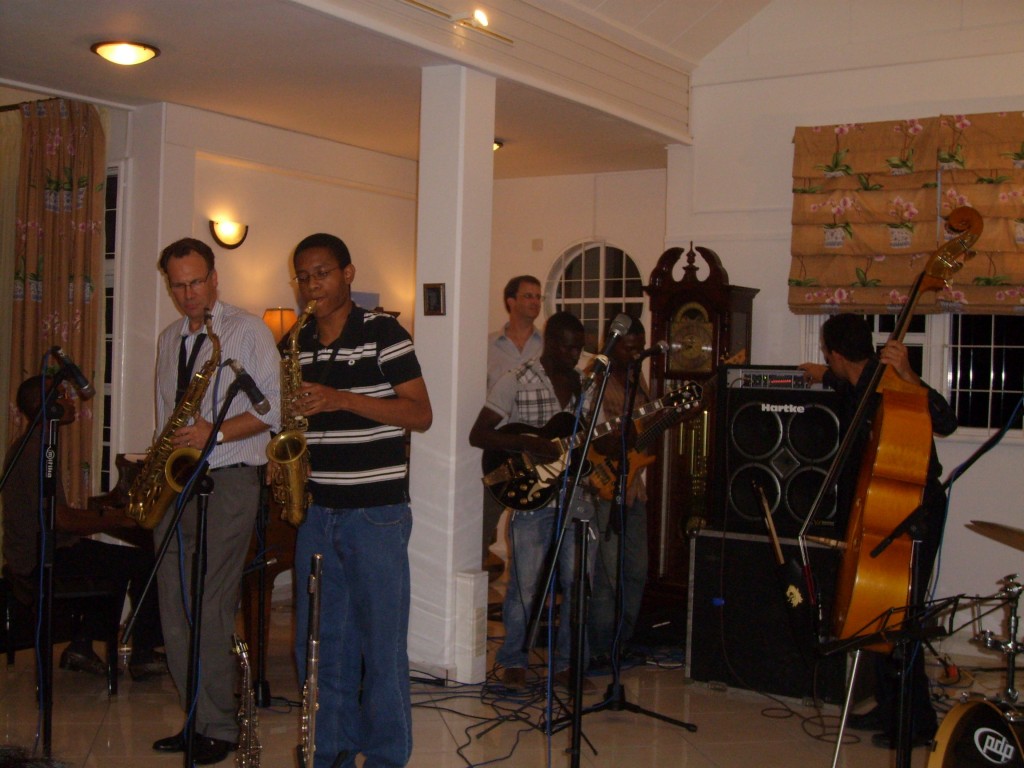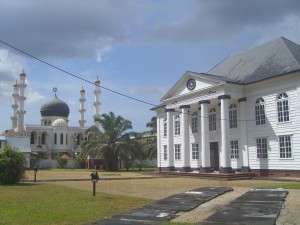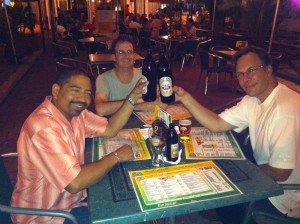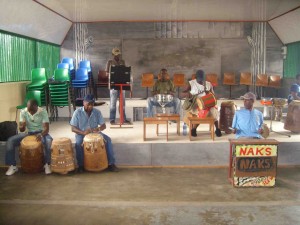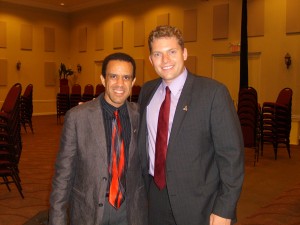This is our second country on the tour and the first time I’ve ever been to South America. We only have 3 days here but 6 events so I know we’re going to be a lot busier than we were in Trinidad. The entire population of Suriname is just under 500,000 people and I’m thinking that Queens alone has about 3.5 million so I’m thinking about how things work here. Turns out that Suriname is massively ethnically diverse just like Queens with lots of spoken languages and influences. Most everyone speaks English or Dutch (as it’s a former Dutch colony and the country is formerly known as Dutch Guinana) and Dutch is the official language but there is another language that’s home here and that is Sranan-Tongo. It seems to be a mix of English, Dutch, and African languages and is only spoken in Suriname. 90% of the population lives on the northern coast (about 20% of the land mass of the country) and the rest of Suriname is jungle which they call “the interior”. Much of the Black population that live in the interior are descendants of former escaped slaves, the Maroons, and have kept their pre-colonial African culture intact. As badly as I wanted to go to “the interior” I knew there wouldn’t be enough time so I was on the lookout for anything that could represent that experience.
We left the International airport at about 1:30am or so and arrived at our hotel in Paramaribo by 2:30am. Sleep was definitely in order as our press conference was scheduled for 1pm and we would have a briefing at the U.S. embassy beforehand with the U.S. Ambassador, John R. Nay, and some of his staff. After a few hours of sleep we were ready for our briefing and to see a little of Paramaribo. There are so many cultures living side-by-side here it’s amazing. Ethnically I believe the largest populations are West African, East Indian, Chinese, Javanese, Lebanese, and Dutch. We all took pictures of a synagogue and a mosque that are right next to each other with no apparent tension between the two religions. There are Christians, Hindu, and Buddhists here as well along with several traditional African and Amerindian religions. The Ambassador and the Deputy Chief of Mission, Susan Bell, are both amazing people with a love for Suriname, it’s people and history and we have a great conversation as we also talk about the upcoming press conference, workshops, and concerts. I find out in the Ambassador’s office that Tim Armacost’s father, Michael Armacost, was the U.S. Ambassador to Japan for 4 years and U.S. Ambassador to the Phillippines for 3 years in the ’80s. I knew his father worked for the State Department but I didn’t know exactly in what capacity. I’ve known Tim for 8 years and I have to come to Suriname with him to find that out! That’s also the fun part of traveling. It’s like suddenly meeting an old friend of yours out of the blue in a hotel lobby in Europe. ![]()
The press conference is hosted at a local jazz club/restaurant. There wasn’t many people there but it was attended by the biggest newspaper in town “De Ware Tijd” and they asked questions, took pictures, and it was in the paper the next day. Here’s a short video clip of Tim and Tony giving them a taste of the upcoming concerts. Just afterward we are treated to a lunch at the restaurant. They prepare a special dish called ‘”grit bana” meaning grated banana. In cooking it’s banana, cassava soup with chicken, beef, and dumplings, and coconut milk mixed together but the significance of the dish is the coming together of the two worlds – the African and the Dutch. Aside from it being a great dish to eat, it is their way of welcoming us to Suriname!
We had a short break before we headed off to our first workshop with younger music students (mostly 10-19 years old) with many music teachers in attendance and we find we can speak English in the workshop. The students are surprisingly good!!! There are different levels of skill but they have the spirit and were relatively fearless when it came to trying new things and going for it. Some of the older students are in their early 20s and some of them are the local teachers. I am surprised at their level of skill and hunger for knowledge seems to be insatiable. We couldn’t give them enough information and they didn’t want the workshop to end. We received a standing ovation at the end and were able to leave them with some ideas, things to work on, a list of great musicians and records to listen to, and tunes that they should know to be able to sit-in with anyone and play jazz anywhere in the world.
We are humbled by their desire to learn but we’re also exhausted. We have dinner near the hotel and start our on-going beer taste contest. We loved the “Carib” beer in Trinidad and the big local beer here is “Parbo”. Along with dinner I order a small Parbo and Tim and Tony order a large. The small is 330 mL but the large turns out to be a 1000mL bottle and yes we had to share and it took some work to finish it all!
The next day we have a workshop at the Ambassador’s residence and a concert later on. This workshop is for more advanced teachers and players so we do a masterclass instead and focus more on them. We meet and hear more knowledge-hungry musicians and classical players (and conductors). The vibe is great and there’s a crew of young jazz musicians that are a tight-knit group that talk to each other and play together frequently. Again we are humbled by their intensity of how much they want to learn. At the end they teach us a popular song in Suriname “Maria”. To close we play our version of it to a standing ovation and invite the players to attend our concert that night and the following night.
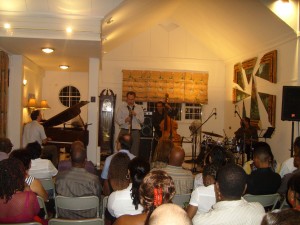 The concert at the Ambassador’s residence is totally packed. It’s a great feeling to play for a packed, appreciative audience. We do two sets and on the last song “Maria” feature some of the musicians who played with us at the workshop who continue to surprise us with some great playing. After another standing-O (I’m enjoying this) there’s plenty of smiles, hand-shaking, hugs, and conversation to go around and again more questions from the local musicians.
The concert at the Ambassador’s residence is totally packed. It’s a great feeling to play for a packed, appreciative audience. We do two sets and on the last song “Maria” feature some of the musicians who played with us at the workshop who continue to surprise us with some great playing. After another standing-O (I’m enjoying this) there’s plenty of smiles, hand-shaking, hugs, and conversation to go around and again more questions from the local musicians.
It’s now our last day and we find out that we can hear a great Suriname drumming ensemble, Ala Kondre, after our soundcheck and radio interview for a our final concert in Suriname. Soundcheck goes well and we answer some questions and do 3 songs for the radio show.
The Ala Kondre Dron Ensemble (“All Countries Drum Ensemble”) is a very special group not just for Suriname but they seem to have a world-wide reputation. It was started in 1971 by a man named Henk Tjon who had a vision to invite all the drumming styles of the different ethnic groups of Suriname and play together as one group. Please, take a few minutes to view this video about Henk Tjon, one of the greatest cultural ambassadors of Suriname. The concept is to celebrate different cultures working together and create something new. The 6 cultures they have represented are: East Indian, Amerindian, African/Maroon, Creole, Lebanese, and Javanese. For the ensemble they were able to gather for us there were 2-3 percussionists representing each cultural group. When they start a piece you can hear that there are 6 distinct rhythmic traditions playing together at the same time, and it works! Myself having a background in percussion I have never seen nor heard anything quite like this before. After playing all together for a short while they break down into solo sections where one distinct drumming style will ‘solo’ and lead the group. When the 2-3 percussionists representing their style are finished with their ‘solo’ the whole group comes back in again in a refrain. After each group has had a chance to lead or ‘solo’ the whole ensemble plays again and finishes the piece. It’s been said that writing about music is like dancing about architecture so here’s a video clip of what Ala Kondre played for us. What we saw is a smaller version of the ensemble as they can have up to 90 percussionists at the same time with the group plus dancers! On their 25th anniversary of being together they had a show featuring over 400 performers play or dance over a period of several hours! Again I’m wondering if Jazz At Lincoln Center has ever heard of this group or how often they travel to the United States. Seeing and hearing this group is an experience I am going to remember for a long time, most likely for the rest of my life. We attempt some musical collaboration with them as Tim Armacost pulls out his saxophone, Tony Jefferson plays some New Orleans-style snare drum, and I play on a djembe-like hand drum. We all get into a group groove, each takes turns soloing, then take it out together with a transformed version of the group groove we started with. Here’s a short clip of Pathways with Ala Kondre.
Our final concert in Suriname is sold out and since we’d like to invite more people between the jazz students and the Ala Kondre percussionists we figure out a way how to print more tickets and add more seats. The 450-seat ballroom is nearly filed to capacity. We’re excited to do the show as the Ambassador is present, many dignitaries of the Surinamese government, and a room full of people excited about what they are about to hear. Our first set goes fantastic doing mostly tunes off the new CD and I don’t mind getting a short break before going into our last set. I dedicate the last set to folk music and among other songs we play my arrangement of a Haitian field song, “Dlo”, our bass-and-drum version of the Jamaican folk song “Brown Skin Girl”, our jazz version of “Frere Jacques/Brother John”, and then invite some of the Suriname jazz players and students to join us in a version of “Maria” which everyone in the room knows. Again a standing ovation and this time also a request for an encore. After doing so many arrangements I want to keep it simple and just play. We end the concert with a Pathways jam session version of Thelonius Monk’s “Rhythm-A-Ning”. Another standing ovation and bows. Everybody is happy and people stay for almost a full hour afterward talking, taking pictures, exchanging emails, signing autographs, hugs, handshakes, and smiles. What an action-packed three days! We have a rest day coming up in Miami before we head out to Nicaragua. We leave the hotel in Paramaribo at 3am to catch the only flight out to Miami that leaves at 6:15am. I make a note to call my friend, great young jazz pianist in New York, Donald Vega, who is from Masaya, Nicaragua, 30 minutes away from Managua which is our next city on the Rhythm Road tour. But for now, we have a rest day in Miami, we’re gonna need it!
-PB
p.s. use this link for more pictures of Paul Beaudry & Pathways in Suriname
p.p.s. our pianist, Bennett Paster, is also keeping a blog
